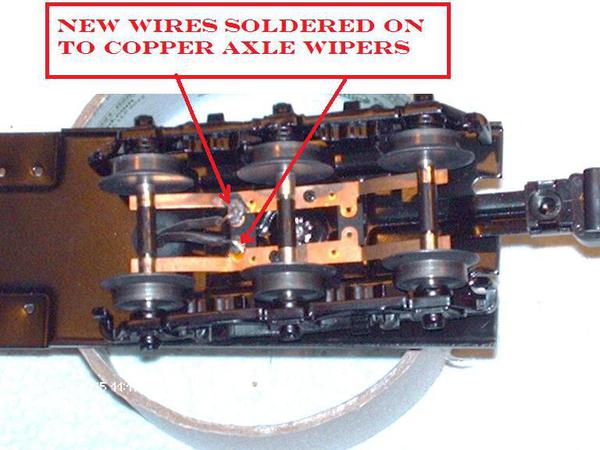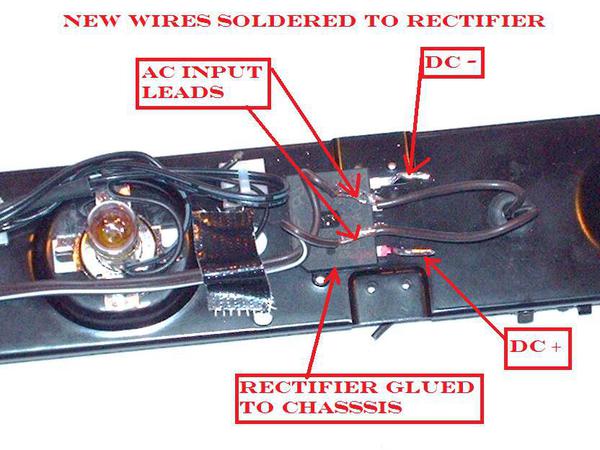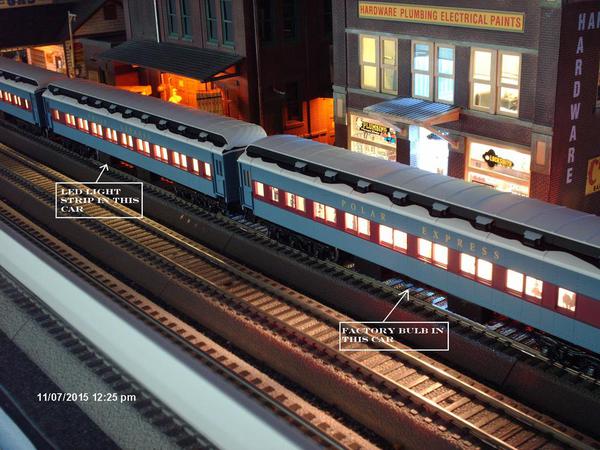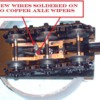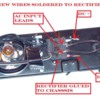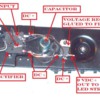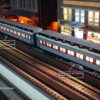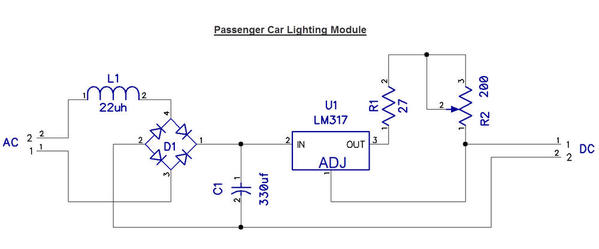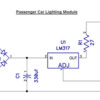Well by now many of us have received our PE sets and overall I think the reviews are pretty positive.
In my set the lighting in the passenger cars was spotty at best in all 5 cars. The lights would flicker frequently and completely turn off at times.
The track was not at fault. Lionels' method of wiring these cars is faulty. Instead of soldering the wires to the copper axle wipers they elected to GLUE the wires to the tabs with some sort of gooey stuff that fails with time.
I decided to convert my cars to LED strip lighting and add a means to keep the lights on even if dirty track is encountered.
Here's how I did it.
1. Here's a picture of the parts needed:
I used some double sided foam mounting tape, a length of LED strip lighting, some flexible wire (22 gauge or similar), a 2 conductor mini male/female plug, a capacitor, a voltage regulator and a rectifier to change the voltage to DC (that's what the LED strips use).
The foam tape is used to make sure the LED strip stays stuck to the roof. The glue on the back of the strips can't be trusted by itself.
The LED strip can be cut at the copper tabs on it every 3 LED's. Cut it just long enough to fit on the flat part of the roof. Mine was five segments long for a total of 15 lights. Keep the paper backing on the strip until later.
The mini plug lets you separate the shell from the chassis at a later date if needed for service issues.
The capacitor acts like a rechargeable battery sort-of. When power is applied to the track the capacitor charges up with DC power and then releases it when called on to do so by an interruption in track power like dirty track.
The voltage regulator keeps the power to the LED strip at a constant 9VDC. That lets them put out full brightness without getting hot at all. We don't want any warped shells do we?
The rectifier changes the track voltage which is 18 VAC to 18 VDC.
It is then stepped down by the regulator to 9 VDC.
OK enough electrical background info. Let's get started again.
Remove the center chassis cover: there is a tab on the end where the printing is on the chassis. It fits in a slot in the floor so lift the other end first.
3. Remove the chassis:
Chassis is off...underside of roof shown:
4. Detach wires from copper axle wipers and save and secure inside chassis if desired:
5. Using some flexible color coded wire solder new wires to tabs as shown:
Make sure the trucks swing freely side to side. Make sure you solder the same color coded wire to the same tab on each truck i.e. right side of car= white striped wire...left side of car = plain colored wire!
6. Glue the rectifier to the car floor and solder the truck power wires to the AC leads (2 center leads) on the rectifier as shown.
It doesn't matter which lead gets which pair of color-coded wires because this is alternating current.
7. Glue the capacitor to the car floor and solder the negative lead (marked by a stripe on the side of the capacitor) to the negative DC output lead on the rectifier. Then solder the positive lead on the capacitor to the positive DC output lead on the rectifier.
Now add the voltage regulator. The flat metal part with the hole in it helps to dissipate heat. Glue this metal part to the car floor. I used hot glue. If you prefer you can drill a small hole in the floor and secure the part to the car floor with a small sheet metal screw through the provided hole in the regulator.
With the regulator on its back secured to the floor and tabs pointing towards you the tabs are as follows:
A. Tab on left is 18VDC in (to be regulated)
B. Center tab is Negative in and out to the light strip (IT'S JUST THE NEGATIVE SIDE OF THE CIRCUIT)
C. Tab on right is 9VDC out to the light strip (This is now regulated power)
Here's a side view:
8. Add the 2 pin male plug...RED WIRE POSITIVE...BLACK WIRE NEGATIVE:
9. Add the foam tape to the car roof:
10. Solder the female half of the two pin plug to the LED strip. THE RED WIRE GOES TO THE POSITIVE SIDE AND THE BLACK WIRE GOES TO THE NEGATIVE SIDE. Do this on a block of wood away from the car shell. It only takes a little dot of solder to do this. Don't take too long soldering these on as too much heat might damage the strip.
Keep the soldering iron tip on the copper tabs and apply a small dot of solder to the copper tabs. Then tin the female plug wire leads and with a little heat from the tip solder them to the dots of solder on the copper tabs.
Practice a few times on some sacrificial 3 light segments to get the feel of how to do it. If I can do it anyone can!
SO...HOW DO WE DETERMINE WHICH SIDE OF THE STRIP IS POSITIVE?????
EASY...TAKE A 9 VOLT BATTERY AND WITH TWO WIRES TOUCH THE BATTERY LEADS TO THE COPPER TABS. WHEN THE STRIP LIGHTS UP MAKE A NOTE OF WHICH SIDE IS POSITIVE FROM THE MARKINGS ON THE BATTERY.
The strips will only light one way and you can't hurt them if you have the wires switched during testing.
Some LED light strips have the positive side marked with a little + sign. Mine did not so I did the battery test.
11.When you have the female plug soldered to the LED strip remove the paper release strips from the back of the LED strip and foam tape, center the led strip in the car roof and stick the two together:
12.Hook the male female plug together with the car roof laying next to the chassis. Apply some AC power to the car wheelsets. The LED strip should light up. If so SUCCESS!![]()
If not.....you'll have to go back and check your work ![]()
Let's assume everything works OK.
13. Reinstall the chassis to the shell reversing the steps you took at disassembly.
Here's some pictures showing the new LED lighting at work.
Room lights off, no power:
Now turn on the power:
Here's a comparison of the LED vs. the factory supplied bulb...(Bulb car is on the right side):
The lighting from the LED strips is softer and uniform end to end in the car. The bulb light is concentrated in the center of the car.
The best part is that all the flickering of the light is eliminated due to the capacitor in the circuit.
That's how I did it. If you want to upgrade your cars to LED give it a try!
Mark




